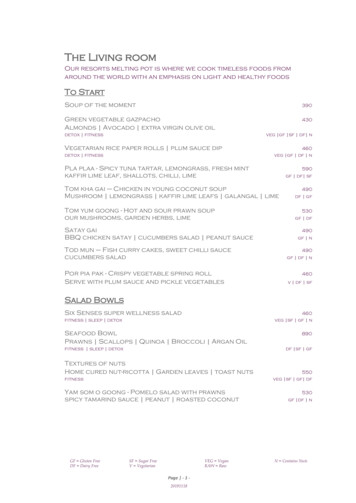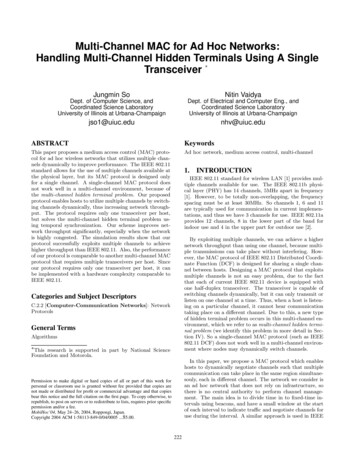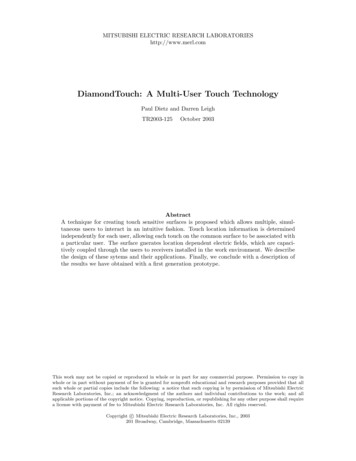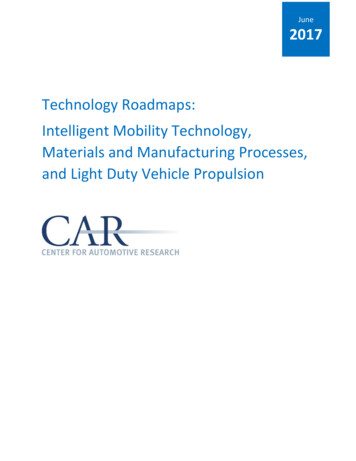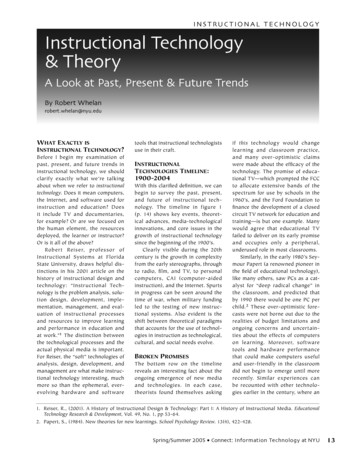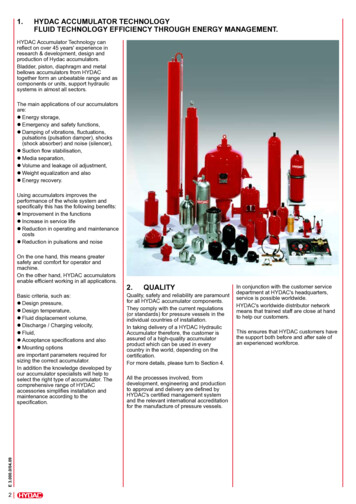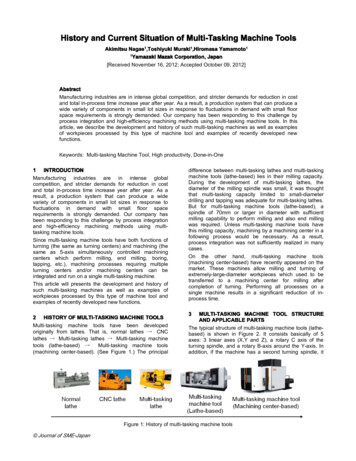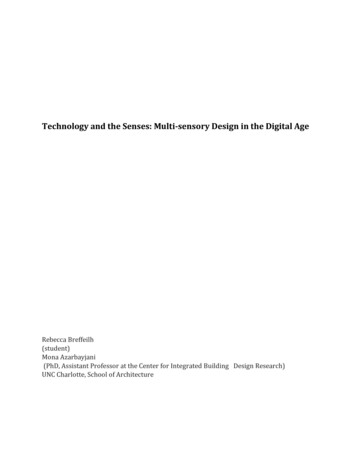
Transcription
Technology and the Senses: Multi-sensory Design in the Digital AgeRebecca Breffeilh(student)Mona Azarbayjani(PhD, Assistant Professor at the Center for Integrated Building Design Research)UNC Charlotte, School of Architecture
Technology and the Senses: Multi-sensory Design in the DigitalAgeABSTRACTAs society progresses into the future, theimpact of technology on different aspectsof our lives will continue to increase. binetechnologicaladvancementswithfundamental sensual qualities.Forarchitecture in the Digital Age,technological implementation too necarefully,technology and digital media can be usedto help stimulate the senses and enhancethe perception of a place. Through thevenues of light, sound, and touch, thispaper investigates how technology andthe senses can work together to impactthe experience of a place.INTRODUCTIONThrough academics, architects are taughtto address various design aspects ofbuilding performance such as context,environment (sun, temperature, wind),culturalaspects,userbehavior,occupancy, and function.Theseconsiderations are combined andmanipulated into a formal aestheticexpression of the architect’s imagination.However, it can be argued that emphasison formal design principles and mediagenerated architecture is coming at theexpense of sensory necessity.In anincreasingly technological-based society,it is understandable that architecturalprinciples would be influenced by bothdigital and technological developments.However, architects must not neglect therole that sensory stimulation plays inboth the design process and theexperience of architecture. With thedirection that architecture is heading, thethinking process of the technologicalapproach needs to be reconsidered inorder to balance the sensory one. Thus,the theoretical arguments in regards tothe significance of multi-sensory designwill be studied in this paper, along withcase studies of how technology and thesenses can work in conjunction with eachother.THE PERCEPTION OF SPACEThe dynamic nature of perception meansthat it is “continuously changing byvarious extents” (Kreji, 2008). Not onlydo people perceive things differently inthe same situation or environment, theyalso apply different meanings to whatthey perceive. It is this variability thatmakes it very challenging for architects toproduce spaces that are equally beneficialand meaningful to their occupants.Because an architect cannot predict anindividual’s reaction to a space, they mustallow their instincts to guide them. But towhat extent should architects rely ontheir instincts to produce emotionalattachment to a building? The way thatdesign arrangements impact emotionalresponses and what those responsesmean to the building’s users areimportant considerations. This idea is afundamental aspect of multi-sensorydesign. By creating a “feast for thesenses” one has more ability to connectwith multiple users on different levels ofexperience (Lehman, 2010). Thus, themore diverse the built environment is the
more sophisticatedperceptions will be.theoccupants’THE COMPONENTS OF MULTISCENSORY DESIGNMulti-sensory design is traditionallyassumed to be design that impacts thefive senses: sight, hearing, taste, touch,and smell.However, this notionencompasses only the most basic conceptof multi-sensory design. In fact, there arethree other systematic concepts related toperception that are incorporated withinmulti-sensorydesign:hapticity,kinesthesia, and syneasthesia. In essence,these systems take the five senses andreformulate them into an active, inclusivesystem that directly impacts theexperience of architecture (Kreji, 2008).Up until now the perception of “space”has been stressed, but it is important tonote a differentiation between space andplace. Place is established from space asit becomes better known and is endowedwith the value that one gives it; this valueis created is through our senses.Therefore, perception of place isessentially“processed”sensation(Malnar, 2004).Although perceptiontechnically only requires gatheringinformation about the environment by atleast one of the senses, the more sensesthat are engaged within a space, theeasier it will be to establish theperception of place. This is why anargument can be made in favor of thenecessity for multi-sensory design withinthe built environment. As the senses areused to establish a place, an experience ofthat place through hapticity, kinesthesia,and syneasthesia will be formed.Picture 1.1 The creation of placeIn psychology, the word haptic refers to“theabilitytoexperiencetheenvironment through active exploration,typically with our hands” (Towards,2010). This means that hapticity issimilar to the act of touching. However,the main difference between touch andhapticity is that touch is oftencharacterized as two-dimensional, and ahaptic experience is three-dimensional(Towards, 2010). The sense of touch ssure,andkinesthesia (Malnar, 2004). Thus, thethird dimension makes movement animportant factor in the experience of aplace.Unlike hapticity, kinesthesia in not adirectinterpretationofone’ssurroundings and, therefore, does notcreate an emotion within the body (Kreji,2008). It does, however, have animportant effect on the senses and is thusentwined with the experience of a place.People understand kinesthesia in asubconscious way, but it is rarelyrecognized because it is constantlyexperienced.In the simplest terms,kinesthesia is the examination of ourenvironmentthroughmovement(Towards, 2010). No matter what type ofmovement occurs, whether it is walking,or even a head or eye-movement, thephysical and reactive quality ofkinesthesia is extremely relevant to theformation of one’s perceptions (Kreji,2008).Thus, kinesthesia affects anexperience through its connection withtouch, movement, and hapticity. A
contemporary example of this philosophyis parkour, which is a physical practice ofexperiencing a place by traversingelements in an urban setting.Syneasthesiaisaninvoluntaryphenomenon that collects sensoryinformation from one sense and transfersit to another (Towards, 2010). Thisimplies that there is no choice but tomake connections between the senseswhen one is experiencing a space.Because of past experiences with certainsensory properties, a person’s memoryinfluences how his or her mind relates toseeing these properties again in thefuture. Thus, syneasthesia unites previoussensory information into one coherentrepresentation of an experience withoutthe need for actual sensation. A simpleexample of syneasthesia is to considerhow people relate the color red to “hot”or blue to “cold” (Towards, 2010). In thisway, syneasthesia has the power to alterperception by causing objects or spacesthat one perceives to essentially enter ourphysical realm.SystemSightTasteSmellTouchHearAnatomyof theOrganOcularMechanism (eyes)Activityof ingTouching,feelingOrientingto soundsStimuliAvailableVariables ofstructuresin ambientlightComposition ofingestedobjectsComposition of themediumTexture,weight, etcVibration inthe airHapticSystemKinesthesiaSynesthesiaSkin,joints, ection andtransferenceVaryingconfigurations oftouchVaryingpositionsandmovementof bodypartsMemoriesTable 1.1 Expanded summarization of thesensory systems (Malnar, 2004)VISUAL PREVALENCEThe challenge with creating multi-sensorydesign is that architecture e of visual qualities over theother senses.This should not besurprising, however, given that formaldesign principles used in academics todayare verifiable elements of architectureand sensory elements are not. Thismeans that to an architectural communitygrounded in aspects that can besubstantiated and observed, the otherfour senses seem unreliable as designparameters (Malnar, 2004).This iscreating an increased interest in thevisual sense and a decreased interest inthe other sensual qualities of the builtenvironment.In addition, architecture is also beinginfluenced more and more by massmedia, fashions, and various digitalmedias (i.e. internet, advertising, andtelevision).Whereas in the pastarchitecture was judged ‘in situ’, imagesof buildings can now be uploaded ontothe computer for everyone, regardless oflocation, to see (Towards, 2010). In
response, architecture has already begunto adapt to our dominance towards thevisual sense and virtual image. Manybuildings no longer create a spatialexperience grounded in expression(Towards, 2010). Before they are evenexperienced, they are judged by theirdigital representation - a representationthat is extending beyond the aestheticalaspects of architecture and into theenvironmental aspects as well.CASE STUDIESMulti-sensory architecture should notonly act as a visual journey but also as aphysical experience in a place. Based onthe different theories involving multisensory design, I have investigated threeelements that I that believe help stimulatea sensory environment: Light, sound, andtouch. Although the importance of theseelements has long been established, inour contemporary culture, technology isquickly becoming an inherent part ofarchitecture. Thus, it is necessary tomerge past methodologies with presentcapabilities.By exploring differentrelationships between light, sound, touch,and technology we will be able to createambiances that act as mediating devicesbetween the two extremes. Along with ananalysis of each element, a correspondingexample of work has been included thatportrays sensual elements through theuse of technological means.LightLight and architecture have long beeninterdependent concepts. Light allowsusers to define the surroundings of aplace and, therefore, forming arelationship between the two isinevitable. According to Pallasmaa thewindow should “act as a mediatorbetween the inside and outside worlds”(Pallasmaa, 1996).Whether light isnatural or artificial, however, is irrelevantto its importance in multi-sensory design;it is the manner in which it expresses aspace that determines its relevancy. Lightis also important because of the shadowsit imparts on spaces. Shadow and lightare connected in a way that few thingsare; light creates shadow, and shadowemphases light (Chapter, 2010). Shadowalso expresses depth and texture ofmaterials, but both light and shadow areneeded to affect the atmosphere of a place(Chapter, 2010).A-Asterisk Architects created a bold,modern design for an office building inShanghi (Picture 1.2). Their inspirationcame from images of shadows and trees,which they perforated onto GRG panels.Behind the panels, white glass helpsenhance the experience by contrastingwith the texture of the panels so that abuilding occupant truly feels like he iswalking underneath trees (Leafy, 2008).The use of light and shadow creates amystical experience that is uncommon tomost office building lobbies.Picture 1.2 Light – Leafy Shade, A-AsteriskArchitects, (Leafy, 2008) retrieved fromwww.a-asterisk.com, 2 Nov. 2010
The advancement of technology hasbroadened the potential of lighting tomanipulate the perception of a place.Architects are no longer required to relyon the sun to create lighting possibilities;the architect can now control light ratherthan simply respond to it. This has ossibilitiesofarchitecture.Color can add anotherdimension to the output as well. Manyarchitects have recently been exploringhow colored light can become moredynamic within a space. An example ofthis can be seen in Beijing’s XicuiEntertainment Complex. The building’scurtain wall integrates the largest displayof colored LED’s in the world and is alsocombined with a photovoltaic system(Giostra, 2010). Thus, multiple types oftechnology have been utilized to create alively display of lights. As the sequence inPicture 1.4 shows, each changing rroundingenvironment depending on whether thecolors are warm or cold and whatarrangement they occur.Picture 1.4 Light – Xicui EntertainmentCenter, Beijing, China, (Giostra, 2008)retrieved age/3/, 3 Nov. 2010SoundHuman beings are active creators ofsound and place, and each are reinforcedby the other. Architects’ concerns withthe acoustical quality of their buildings iscertainly not a new concept; however, ourability to control and manipulate thesound within a building is becoming moresophisticated (Chapter, 2010).Newdigital technologies now allow sound toinfluence architectural space and be adesign tool, rather than a second thought.The omnipresence of sound in the builtenvironment makes it important forarchitects to understand the effect andmeaning associated with spatial sound.The relationship between sound andarchitecture can even be taken a stepfurther than acoustical considerationsand sound generation in a building. Withnew digital and sound technologies it maypossible to manipulate musical soundproperties into a physical architecturalspace. No longer will sound only becapable of affecting the atmosphere of abuilding, but it can now affect the physicalenvironment as well. Current researchbeing performed by Jesper Bonde dealswith the relationship between music,body, and architecture in order to developa tool based on the qualitative and
quantitative parameters of sound. Bydigitizing the process of producing musicand architecture the two can be linked toform a dynamic architectural experience(Bonde, 2010). Picture 1.5 illustratespossible building outcomes generatedfrom musical digitalization and thedifferent experiences that they couldcreate. In my opinion, the first imagecreates a perception of mystery, while thesecond one creates a perception of energyand
architecture. Color can add another dimension to the output as well. Many architects have recently been exploring how colored light can become more dynamic within a space. An example of this can be seen in Beijing’s Xicui Entertainment Complex. The building’s curtain wall integrates the largest display
